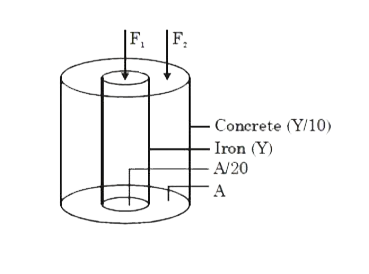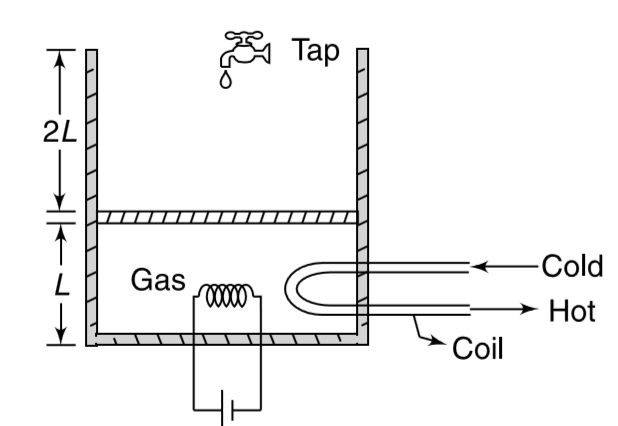A reinforced concrete column consists of concrete filled with iron bars. Assume that iron occupies one-twentieth of the total cross-section area and Young's modulus of concrete is one-tenth of that of iron. The concrete column is under a compressive load P. Determine the fraction of load on the concrete.
The concrete and iron sections are subjected to the same strain. If σc and σi denote compressive stress , Ac and Ai cross-section areas and Yc and Yi Young's moldulus respectively,
σcYc=σiYi
Let x fraction of load P be shared by concrete then we have
xFAcYc=F−xFYiAi
or x=AcYcAiYi+AcYc
On substituting Yc=110Yi,Ai=120Ac, we get
x=AcYc120Ac×10Yc+AcYc=23
Topper's Solved these Questions
- BOOK - NARAYNACHAPTER - MECHANICAL PROPERTIES OF SOLIDSEXERCISE - C.U.Q74videos
MECHANICAL PROPERTIES OF SOLIDS
- BOOK - NARAYNACHAPTER - MECHANICAL PROPERTIES OF SOLIDSEXERCISE - LEVEL-I (C.W)37videos
MECHANICAL PROPERTIES OF SOLIDS
- BOOK - NARAYNACHAPTER - MECHANICAL PROPERTIES OF FLUIDSEXERCISE - EXERCISE - III30videos
MECHANICAL PROPERTIES OF FLUIDS
- BOOK - NARAYNACHAPTER - MOTION IN A PLANEEXERCISE - Level-II(H.W)31videos
MOTION IN A PLANE
Similar Questions
A concrete column is reinforced with an iron rod in the middle. It is subjected to compression by a certain load. Assuming that the modulus of elasticity of concrete is one-tenth that of iron and the area of cross section of the iron is one-twentieth that of concrete, find the portion of the load acting on the concrete.
 View Solution
View SolutionA uniform bar of length 2 m and cross-sectional area 50cm2 is subjected to a tensile load 100 N. If Young's modulus of material of bar is 2×107N/m2 and poisson's ratio is 0.4, then determine the volumetric strain.
View Solution
Knowledge Check
- Question 1 - Select One
An iron bar of length L, cross-section area A and Young's modulus Y is pulled by a force F from both ends so as to produce an elongation l . Which of the following statements is correct?
Al∝YBl∝1ACl∝ADl∝1L - Question 2 - Select One
The increase in energy of a metal bar of length L and cross-sectional area A when compressed with a load M along its length is (where, Y= Young's modulus of the material of metal bar)
AFL2AYBF2L2AYCFLAYDF2L22AY - Question 3 - Select One
A load o f 1 kg weight is a attached to one end of a steel wire o f area of cross-section 3mm2 and Young's modulus 1011N/m2 . The other end is suspended vertically from a hook on a wall , then the load is pulled horizontally and released .When the load passes through its lowest position the fraction al change in lenght is (Takeg=10m/s2)
A0.3×10−4B0.3×10−3C0.3×103D0.3×104
The bar shown in the figure is made of a single piece of material. It is fixed at one end. It consists of two segments of equal lengh L/2 each but different cross sectional area A and 2A. Find the ratio of total elongation in the bar to the elongation produced in thicker segment under the action of an axial force F. Consider the shape of the joint to remain circular. (Given :Y is Young's modulus.
View SolutionThe bar shown in the figure is made of a single piece of material. It is fixed at one end and consists of two segments of equal length L2 but different cross-section area A and 2A. What is the change in length of the system under the action of an axial force F. [ consider the shape of joint to remain circular, Y is young's modulus]
 View Solution
View SolutionA cylindrical container of height 3L and cross sectional area A is fitted with a smooth movable piston of negligible weight. It contains an ideal diatomic gas. Under normal atmospheric pressure P0 the piston stays in equilibrium at a height L above the base of the container. The gas chamber is provided with a heater and a copper coil through which a cold liquid can be circulated to extract heat from the gas. Volume occupied by the heater and the liquid coil is negligible. Following set of operations are performed to take the gas through a cyclic process.
(1) Heater is switched on. At the same time a tap above the cylinder is opened. Water fills slowly in the container above the piston and it is observed that the piston does not move. Water is allowed to fill the container so that the height of water column becomes L. Now the tap is closed.
(2) The heater is kept on and the piston slowly moves up. Heater is switched off at the time water is at brink of overflowing.
(3) Now the cold liquid is allowed to pass through the coil. The liquid extracts heat from the gas. Water is removed from the container so as to keep the position of piston fixed. Entire water is removed and the gas is brought back to atmospheric pressure.
(4) The circulation of cold liquid is continued and the piston slowly falls down to the original height L above the base of the container. Circulation of liquid is stopped. Assume that the container is made of adiabatic wall and density of water is ρ. Force on piston due to impact of falling water may be neglected.
(a) Draw the entire cycle on a P–V graph.
(b) Find the amount of heat supplied by the heater and the amount of heat extracted by the cold liquid from the gas during the complete cycle.
 View Solution
View SolutionWhy is only iron or steel used as reinforcement in concrete structures, while others metals ,duralumin for example , are never employed ?
View SolutionA load of 1kg weight is attacheed to one end of a steel wire of cross sectional area 3mm2 and Young's modulus 1011N/m2. The other end is suspended vertically form a hook on a wall, then load is pulled horizonatally and relased. When the load passes through its lowest position the fractional change in length is (g=10m/s2)
View Solution

